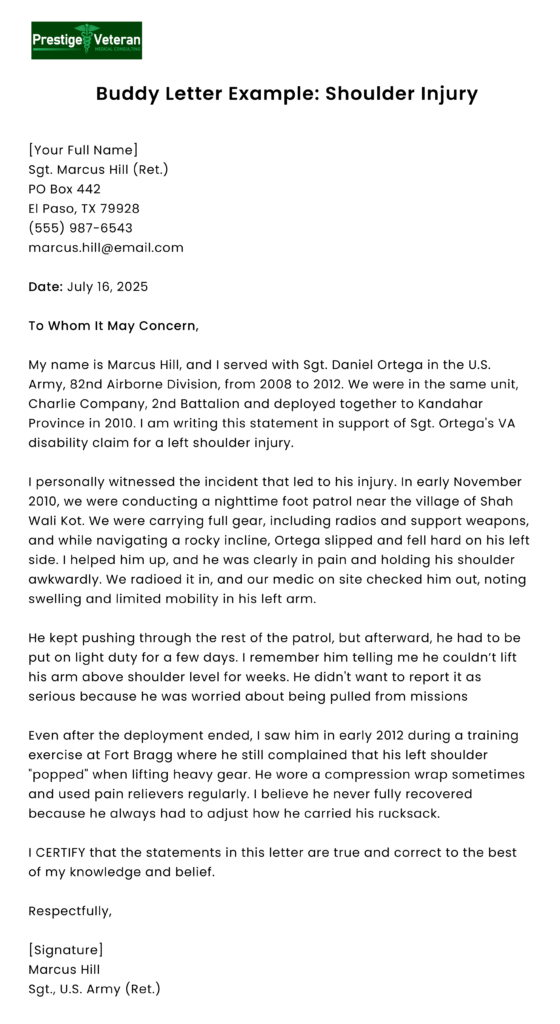A buddy letter for a VA disability claim is one of the most powerful and overlooked forms of support a veteran can receive. Whether written by a friend, spouse, or fellow service member, these letters offer personal insight that helps bridge gaps in official records.
In this guide, we will walk you through what VA buddy letters are, who can write one, and how many Veterans often craft a compelling, legally useful statement. Whether you are a veteran seeking support or someone close to one, understanding this process can make a real difference in a claim’s outcome.
Table of Contents
What is a VA Buddy Letter? And How Does It Help Veterans?
A VA buddy letter is a personal statement written by an individual who knows a veteran well and can offer firsthand knowledge or observations about the veteran’s condition or service-related experiences to support a VA disability claim.
Also known as lay statements, these letters can help fill in the blanks where service records, medical documentation, or official reports are lost, destroyed, or never existed.
For example, a squadmate might write that during a deployment, they saw the veteran thrown to the ground by a nearby blast. The injury wasn’t reported at the time, but years later, the veteran now suffers from back pain and nightmares linked to that event. In such circumstances, a VA buddy letter for back pain might support the claim.
Typically, buddy statements for a veteran help them prove VA disability in two ways:
- To corroborate an in-service event or injury
- To describe how a service-related condition affects the veteran’s everyday life
Under the Veterans’ Claims Assistance Act of 2000, the VA has a duty to assist veterans in gathering supporting evidence and consider lay evidence, such as buddy statements. It’s one of the most underrated pieces of evidence that can cut through the bureaucracy and reach the decision-makers.
Who Can Write a VA Buddy Statement?
Anyone who has direct, firsthand knowledge of a veteran’s condition or service-related experience is suitable to write a VA buddy letter.
The most effective buddy letters typically come from individuals who have closely witnessed the veteran’s challenges and can offer honest and detailed observations.
Some of the common buddy letter authors include:
- Spouses or domestic partners
- Adult children
- Close friends and roommates
- Fellow service members
- Parents or siblings
- Employers or co-workers
- Pastors or mentors
- Caregivers
Each of these writers brings a different perspective. A spouse might describe how PTSD affects family dynamics. A fellow soldier can recall an in-service incident that wasn’t officially documented. An employer can speak to how a veteran’s back injury has impacted their work performance.
Who writes the buddy statement depends on what the veteran is trying to establish in their VA claim.
You, the veteran, can also write your own buddy statement (often called a personal statement for a VA claim), and it can be submitted alongside others to support your disability claim.
How to Write a Buddy Letter for the VA
A buddy letter for a veteran is more than a few paragraphs of support; rather, it’s a clear, specific, and legally valuable account. Hence, VA raters will often consider buddy statements that meet specific criteria.
Here’s a basic structure to follow:
1. Introduce Yourself and State the Relationship
Begin your buddy letter by identifying yourself. State your full name, contact information, and your relationship to the veteran (include the name of the veteran). Mention how long you have known them, how frequently you interact, how you met, and other relevant information. This builds credibility. If you served with the veteran and are corroborating an in-service stressor, provide details on your unit and duty location.
For example:
“My name is Daniel Brooks. I am the former employer of veteran Michael Turner. He worked for me as a logistics coordinator at Brooks Freight Solutions from 2014 to 2020. We worked together closely daily for six years. During that time, I observed how his service-connected migraines affected his ability to focus, maintain productivity, and manage his workload.”
2. Describe the Incident or Behavior Observed
In this part of VA buddy letters, clearly explain the service-related incident or behavioral changes you witnessed in the veteran over time. If you are a fellow service member, describe the exact chronology, dates, and locations of the in-service event that caused or aggravated the current injury or illness.
As a family member or friend, talk about the change in the veteran’s behavior since returning from service and any noticeable changes in moods, physical health, or social life. Whether it’s a wife’s VA buddy letter or a colleague’s, it should be factual, specific, and free of assumptions or exaggeration.
This brief but thorough observation helps the VA understand how the condition is service-connected, making your buddy statement a vital part of the VA disability claim process.
For example,
“In 2015, after returning from deployment, my father, Steven, began complaining about chest pain and shortness of breath. He had never shown signs of heart trouble before. Over time, I noticed he was more fatigued, avoided physical activity, and often had to rest after simple tasks.”
3. Explain Symptoms and Their Impact Today
If you have been asked to write a buddy statement supporting a case for VA disability compensation, explain how the veteran’s current symptoms affect their daily life. Mention daily struggles, work difficulties, social isolation, or physical limitations the veteran faces because of their service-connected disability. Personal accounts from family members, caregivers, and coworkers can help the VA better assess the condition’s severity for accurate rating and compensation.
For example,
“David’s PTSD causes frequent mood swings, and he struggles to sleep more than a few hours a night. He gets anxious in crowded places and avoids going out on weekends. He works part-time from home but often has to take days off when his symptoms flare up.”
4. Finish With a Certification, Date, and Signature
Close the letter with a standard certification statement to testify that the information provided is “to the best of your knowledge and belief.” Don’t forget to sign and date the letter. Your signature confirms the accuracy of your statement and authorizes its use in support of the veteran’s VA disability claim. Also, include your email address and phone number for follow-up.
Example:
“I certify that the statements in this letter are true and correct to the best of my knowledge and belief.”
Lucy Morgan
March 5, 2025
This structure helps ensure your statement is credible and helpful. You can consult a VA-accredited attorney or claims agent to further strengthen its effectiveness.
Buddy Letter Example #1: From Wife – Supporting Claim for Depression

Buddy Letter Example #2: From Fellow Veteran Supporting Claim for Shoulder Injury

What is VA Form 21-10210? Why Use It for Submission?
The VA Form 21-10210 – Lay/Witness Statement is the designated format for submitting a buddy letter. This form replaced the older VA Form 21-4138, Statement in Support of a Claim, and is specifically designed for submission of lay evidence like VA buddy statements. Although both forms can be filled out to submit a testimony for the veteran’s case.
This VA buddy letter form asks for:
- The veteran’s name, SSN, and contact info
- The witness’s (author’s) contact details
- A blank space for the buddy statement
- Signature and date
The form often makes it easier for VA officials to link the lay evidence directly to a claim and helps ensure it’s not overlooked. It also provides legal language that satisfies certification requirements.
When opting to use this form, every individual writing a buddy letter should complete and submit a separate VA Form 21-10210. If you are submitting two buddy statements, for example, one from a spouse and another from a former employer, you will need two completed forms.
Remember: Even if you handwrite or type buddy letters for a VA disability claim separately, attach them to this form when applicable or reference the veteran’s full legal name and file number.
When Should You Submit a Buddy Letter?
A VA buddy statement can be submitted at multiple points during the VA claims process, depending on your requirements. The best time to submit lay evidence is often at the beginning of a new claim, but they are just as effective when added to an appeal, supplemental claim, or request for increased rating.
Here are key scenarios where buddy letters are especially useful:
- When you are missing service records
- When you never sought treatment during service
- When the results of your Compensation and Pension (C&P) exam don’t translate to your condition’s severity
- When trying to increase your VA rating
- When applying for TDIU (Total Disability based on Individual Unemployability)
You can also use buddy letters to explain delayed symptoms, such as PTSD that worsens over time, military sexual abuse incidents that often go unreported, or conditions that don’t always come forward on a medical exam, like migraines or tinnitus.
You may submit these lay statements with your initial claim on VA.gov, or by mail or fax to your VA regional office. Always retain a copy for your records.
Expert Tips for a Successful VA Buddy Letter
Writing a lay statement or buddy statement can greatly strengthen a veteran’s claim for disability benefits in some cases. Once you understand how to structure it, the next step is making your statement stand out.
Here are tips to provide a testimony that the VA can’t ignore:
1. Align Your Statement With the Claim’s Goal
Ask the veteran exactly what they are trying to prove with your buddy letter for the VA, then write accordingly. If the veteran seeks service connection, describe the in-service event you witnessed or learned about. For increased ratings, focus on the progression and current severity of symptoms, and their effect on everyday life.
2. Be Specific With Dates and Patterns
VA reviewers assess the credibility of buddy statements by searching the consistent patterns and details over time. Include timelines, months, or known milestones to create a clear picture.
For example, say, “Since early 2020, she’s missed work at least twice a month due to migraine episodes,” or “He’s had worsening back pain since a fall during active duty in October 2017,” instead of using general terms.
Including specifics helps VA raters verify the claim quickly and accurately.
3. Describe Firsthand, Observable Behavior
A strong VA buddy statement example uses facts to describe the veteran’s disability without speculating or being overly emotional. Stick to symptoms you have personally seen, like nightmares, physical limitations, or isolation.
Instead of “He can’t walk much,” say: “He limps heavily after walking just a few blocks and avoids stairs altogether due to knee pain.”
Statements based on observable behavior carry more evidentiary weight than sympathy.
4. Address Missing or Lost Documentation
Buddy letters for the VA are especially powerful evidence when official records are missing or incomplete, such as in cases of military sexual trauma (MST) or unrecorded combat incidents. Describe how the veteran behaved before and after the incident, and explain why it may not have been formally documented.
5. Offer a Unique Perspective
A single buddy statement is helpful, but multiple, consistent statements from different perspectives may create a fuller picture. A spouse can speak to emotional and family impact, a coworker to job limitations, and a fellow veteran to combat events. Veterans should take time to carefully select buddy letter writers.
6. Keep It Professional and Focused
The VA processes thousands of documents. Limit the VA buddy letter content to one page, ideally 3 to 5 focused paragraphs. Use plain language and avoid military slang unless relevant. Always proofread before submitting. A well-organized letter reflects seriousness and respect for the VA claims process.
7. Submit It on VA Form 21-10210
Use VA Form 21-10210 to submit your buddy statement officially. While handwritten or typed letters are acceptable, using this form ensures the VA processes and attaches the letter correctly to the veteran’s claim. Include your full contact information, date, and signature to validate its authenticity.
By applying these expert tips, your VA buddy statement becomes strong lay evidence that could be the key to securing well-deserved benefits.
If you are unsure about how to structure the letter according to the VA requirements, consider seeking help from a Veterans Service Officer (VSO) or a VA-accredited representative. They can guide you through the process and see if the letter is submitted properly.
Final Thoughts
Writing a VA buddy letter is a meaningful way to support a veteran’s claim, but it’s important to get it right. The key is to be honest, specific, and focused on firsthand experiences. If you are supporting a veteran through this journey, ask them what specific condition or event your letter should focus on, making your statement as relevant as possible. Keep it respectful, clear, and submit it properly using the recommended VA form. Your support could be the piece that helps a veteran receive the benefits they truly deserve.
FAQs
How do I write a good buddy letter for VA disability?
A supportive VA buddy letter should be a clear, specific, and firsthand account of the veteran’s condition or service-related experience, written in a structured format that includes your relationship, observed events, symptom impact, and a signed certification.
Does the VA verify buddy letters?
Yes, the VA considers buddy letters as valid lay evidence and evaluates their credibility based on specificity, consistency, and direct observation, especially when official records are missing or incomplete.
What is the VA Form 21-10210 used for?
VA Form 21-10210 is the official form used to submit lay or buddy statements in support of a VA disability claim, ensuring they are properly certified and linked to the veteran’s file.
How many buddy letters can I write for the VA?
There’s no set limit on how many buddy letters can be submitted, but each should be from a unique individual with firsthand knowledge and must be accompanied by a separate VA Form 21-10210.
How is a buddy letter different from a lay statement?
While the terms “buddy letter” and “lay statement” are often used interchangeably, the main difference is that a buddy letter usually comes from a fellow service member, whereas a lay statement is written by anyone familiar with your condition, yet both serve to support your VA claim.
Does a buddy statement need to be notarized?
A buddy statement is often notarized if it isn’t submitted on VA Form 21-4138, to officially confirm that the information shared is truthful. It is best to follow up with an accredited legal professional when reviewing these documents for submission.
How to submit a VA buddy statement?
Use either VA Form 21-10210 (Lay/Witness Statement) or VA Form 21-4138 (Statement in Support of Claim) to submit buddy letters.
Also read: Why Veterans Can Benefit From A Strong Nexus Letter For VA Disability Claims
At Prestige Veteran Medical Consulting, a veteran-owned company, we specialize in Independent Medical Opinions (IMOs) known as Nexus letters.
Our purpose is to empower YOU, the veteran, to take charge of your medical evidence and provide you with valuable educational tools and research to guide you on your journey.
Understanding the unique challenges veterans face, our commitment lies in delivering exceptional service and support.
Leveraging an extensive network of licensed independent medical professionals, all well-versed in the medical professional aspects of the VA claims process, we review the necessary medical evidence to incorporate in our reports related to your VA Disability Claim.
Prestige Veteran Medical Consulting is not a law firm, accredited claims agent, or affiliated with the Veterans Administration or Veterans Services Organizations. However, we are happy to discuss your case with your accredited VA legal professional.













